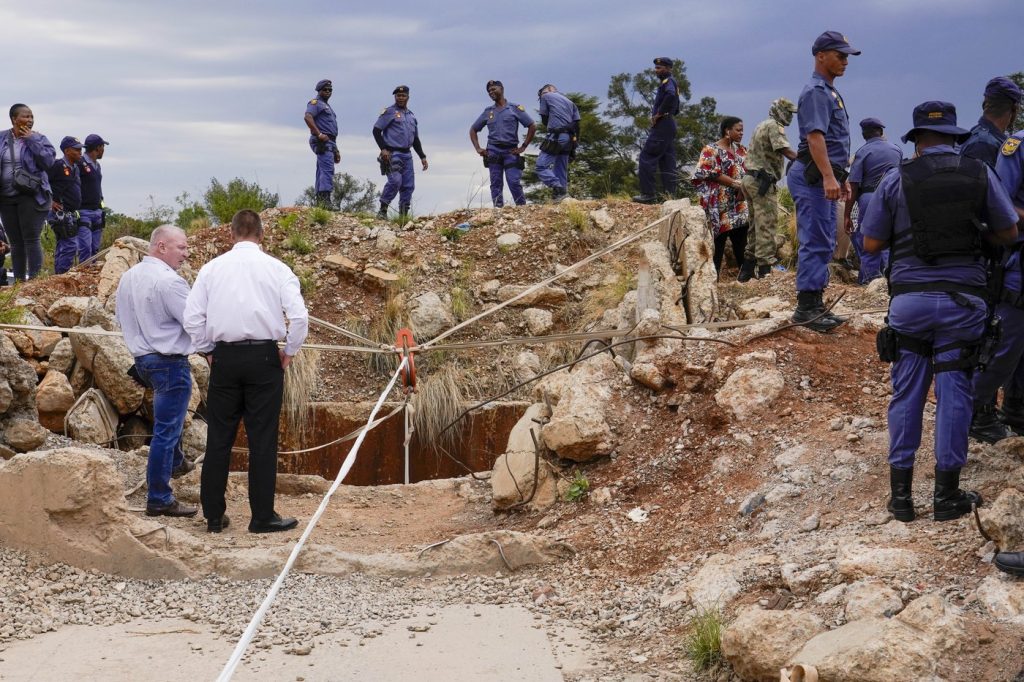STILFONTEIN, South Africa – Rescuers have initiated efforts to rescue illegal miners trapped for months in one of South Africa's deepest gold mines. On Tuesday, a cage-like structure was deployed into an abandoned shaft at the Buffelsfontein Gold Mine, where it is estimated that over 500 miners remain trapped, many suffering from starvation and dehydration. This operation comes amidst reports that more than 100 miners are feared dead since these individuals have been underground for an extended period, with some believed to have been trapped since July.
Civic organizations and miner advocacy groups have raised alarms about the dire situation, stating that since Friday, at least 24 bodies have been recovered, along with 34 survivors. Mzukisi Jam, regional chairperson of the South African National Civics Organization, indicated that six bodies and eight survivors were extracted early Tuesday, but the overall situation remains critical with many miners reportedly ill and weak. The police have assessed that hundreds of miners might still be underground, although they are uncertain of the exact number.
The mine, located near Stilfontein, southwest of Johannesburg, has faced a tense standoff between police, miners, and community members since November. The authorities initially attempted to force the miners to come out as they launched operations against illegal mining activities. However, relatives of the trapped miners contest the notion that the miners can easily exit, claiming that the shaft is too steep and the original ropes and pulleys used for access have been removed. Rights activists have condemned police actions, suggesting that the cutting off of food and water supplies has contributed to the deteriorating health of the miners.
Jam expressed dissatisfaction with the delays in the rescue operation, stating, “We are happy that this (rescue) operation is happening, even though we believe that if it was done earlier, we wouldn’t even have one dead person.” The prevalence of illegal mining has surged in South Africa as many formal mining companies abandon less profitable mines, leaving informal miners to risk their lives underground in search of remaining gold deposits. Miners often take supplies with them, relying on those outside the mine to send in additional resources during their subterranean ventures.
Some miners have successfully escaped in the past few months and faced arrest upon emerging. Authorities assert that fear of police intervention prevents many from leaving. Rights groups elaborate that the safe exit is grueling, requiring miners to navigate through various tunnels and shafts that could take days. With the mine being approximately 2.5 kilometers (1.5 miles) deep and complex in its design, many miners are either too frail or unwell to undertake this challenging journey.
Families and community members have gathered anxiously near the mine, waiting for updates on their loved ones. A local rescue operation was initiated prior to the formal efforts by authorities. Zinzi Tom, a sister of one of the trapped miners, reported, “The last time I spoke to my brother was in July, when he told us that he is going underground. We had not heard anything from him, but yesterday one of the miners who surfaced said he saw him about two weeks ago. Apparently, he is very sick and he is struggling to survive.”
The Mining Affected Communities United in Action group has taken legal action against the authorities, insisting that food, water, and medical assistance should be provided to the miners. Disturbing cellphone videos purportedly taken underground have emerged, showing dozens of deceased miners wrapped in plastic. One video captures a miner stating, “This is hunger. People are dying because of hunger,” as he pleads for help and assistance.
As scrutiny on the government's handling of the situation increases, South Africa's ministers of police and mineral resources were scheduled to visit the mine. In a previous statement, South African Cabinet Minister Khumbudzo Ntshavheni declared that the government considered the miners as “criminals” and would not provide aid to them, stating, “We are going to smoke them out. They will come out.”










